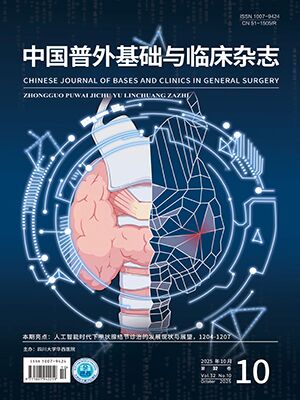| 1. |
Siegel R, Naishadham D, Jemal A. Cancer statistics, 2013[J]. CA Cancer J Clin, 2013, 63(1):11-30.
|
| 2. |
Laszlo L. Predictive and Prognostric Factors in the complex treatment of patients with colorectal cancer[J]. Magy Onkol, 2010, 54(4):383-394.
|
| 3. |
中華人民共和國衛生部.中國癌癥預防與控制規劃綱要(2004~2010)[J].中國腫瘤, 2004, 13(2):65-68.
|
| 4. |
Shayakhmetov DM, Di Paolo NC, Mossman KL. Recognition of virus infection and innate host responses to viral gene therapy vectors[J]. Mol Ther, 2010, 18(8):1422-1429.
|
| 5. |
Chen EQ, Song XQ, Wang YL, et al. Construction of a highly-active, liver-specific transcriptional regulatory element through combination of the albumin promoter andα-fetoprotein enhancer[J]. Plasmid, 2011, 65(2):125-131.
|
| 6. |
Dong K, Wang R, Wang X, et al. Tumor-specific RNAi targeting eIF4E suppresses tumor growth, induces apoptosis and enhances cisplatin cytotoxicity in human breast carcinoma cells[J]. Breast Cancer Res Treat, 2009, 113(3):443-456.
|
| 7. |
Asayama M, Kadowaki S, Yamaguchi K. Issues of molecular targeted therapies in combination with chemotherapy in metastatic colorectal cancer[J]. Nihon Rinsho, 2011, 69(3):464-471.
|
| 8. |
Law AYS, Ching LY, Lai KP, et al. Identification and characterization of the hypoxia-responsive element in human stanniocalcin-1 gene[J]. Mol Cell Endocrinol, 2010, 314(1):118-127.
|
| 9. |
Shi Q, Zhang P, Zhang J, et al. Adenovirus-mediated brain-derived neurotrophic factor expression regulated by hypoxia response element protects brain from injury of transient middle cerebral artery occlusion in mice[J]. Neurosci Lett, 2009, 465(3):220-225.
|
| 10. |
Wang W, Sun XJ, Lu L, et al. Cytotoxicity of lymphocytes activ-ated by superantigen toxic-shock-syndrome toxin-1 against colorectal cancer LoVo cells[J]. Mol Cell Biochem, 2013, 376(1-2):1-9.
|
| 11. |
Marignol L, Foley R, Southgate TD, et al. Hypoxia response element-driven cytosine deaminase/5-fluorocytosine gene therapy system:a highly effective approach to overcome the dynamics of tumour hypoxia and enhance the radiosensitivity of prostate cancer cells in vitro[J]. J Gene Med, 2009, 11(2):169-179.
|
| 12. |
Ruan H, Su H, Hu L, et al. A hypoxia-regulated adeno-associa-ted virus vector for cancer-specific gene therapy[J]. Neoplasia, 2001, 3(3):255-263.
|
| 13. |
范永衛, 楊赤, 萬玉良, 等.人端粒酶逆轉錄酶啟動子介導的靶向性腫瘤基因治療的研究進展[J].第四軍醫大學學報, 2009, 30(12):1149-1151.
|
| 14. |
Wang W, Jin B, Li W, et al. Targeted antitumor effect induced by hTERT promoter mediated ODC antisense adenovirus[J]. Mol Biol Rep, 2009, 37(7):3239-3247.
|
| 15. |
Nemunaitis J, Tong AW, Nemunaitis M, et al. A phase I study of telomerase-specific replication competent oncolytic adenovirus (telomelysin) for various solid tumors[J]. Mol Ther, 2010, 18(2):429-434.
|
| 16. |
Bougel S, Renaud S, Braunschweig R, et al. PAX5 activates the transcription of the human telomerase reverse transcriptase gene in B cells[J]. J Pathol, 2010, 220(1):87-96.
|
| 17. |
Li JT, Bian K, Zhang AL, et al. Targeting different types of human meningioma and glioma cells using a novel adenoviral vector expressing GFP-TRAIL fusion protein from hTERT promoter[J]. Cancer Cell Int, 2011, 11(1):35-48.
|
| 18. |
王宏芳, 劉揚, 李金華, 等.雙重靶向條件復制型腺病毒的包裝及抗腫瘤作用[J].西安交通大學學報:醫學版, 2013, 33(3):308-312.
|
| 19. |
Zhang P, Tan J, Yang DB, et al. Gene therapy using the human telomerase catalytic subunit gene promoter enables targeting of the therapeutic effects of vesicular stomatitis virus matrix protein against human lung adenocarcinoma[J]. Exp Ther Med, 2012, 4(5):859-864.
|
| 20. |
Hashimoto Y, Tazawa H, Teraish F, et al. The hTERT promoter enhances the antitumor activity of an oncolytic adenovirus under a hypoxic microenvironment[J]. PLoS One, 2012, 7(6):e39292.
|
| 21. |
鄭見寶, 孫學軍, 王煒, 等. HIF-1α與CDX2在結直腸腺癌組織中的表達及意義[J].中國普外基礎與臨床雜志, 2010, 17(12):1113-1117.
|
| 22. |
Zheng JB, Sun XJ, Qi J, et al. Effects of homeodomain protein CDX2 expression on the proliferation and migration of Lovo colon cancer cells[J]. Pathol Oncol Res, 2011, 17(3):743-751.
|
| 23. |
李守帥, 孫學軍, 鄭見寶, 等.尾型同源盒基因-2過表達對結腸癌細胞生物學性狀的影響[J].西安交通大學學報:醫學版, 2011, 32(1):114-118.
|
| 24. |
Zheng JB, Sun XJ, Wang W, et al. Hypoxia-inducible factor-1αmodulates the down-regulation of the homeodomain protein CDX2 in colorectal cancer[J]. Oncol Rep, 2010, 24(1):97-104.
|
| 25. |
鄭見寶, 孫學軍, 王煒, 等.缺氧下調結腸癌細胞株CDX2表達的研究[J].中國普通外科雜志, 2010, 19(4):364-368.
|




